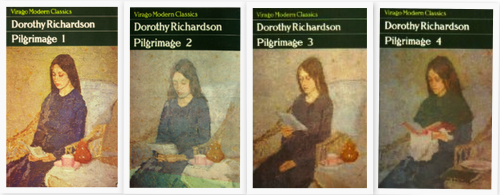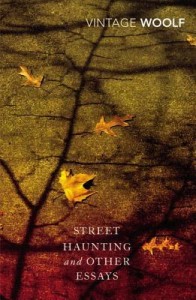The passing of the historical figure paved the way for the resurrection of the flâneur as a methodological persona, adopted in order to pursue the exploration of the city. Stripped to its basic characteristics and used as a modus operandi for the writer, flânerie, as a scopic methodology, involves mobile observation on the part of an individual consciousness from the supposed viewpoint of a pedestrian city dweller.[i]
Modernism is very much an urban phenomenon. Whilst writers of previous generations, such as Dickens, Gissing and Wells, wrote about the city, it was the early modernist writers, most notably Woolf, Joyce and Richardson, who developed new ways to represent the psychological impact of urban life. The early twentieth-century saw an explosion of new freedoms for women, and middle-class women, many of them newly empowered into roles in academia and the professions, together with an expanded role as consumers, became more evident on the city streets. Women writers, Mansfield, Richardson and Woolf in particular, began to write about the new types of women that they saw about them. These, and other, modernist writers stretched the boundaries of narrative form and used fiction not so much to tell a ‘story’, but to explore the very nature of consciousness. In the case of Richardson and Woolf, this was, in essence, an examination of the nature of female consciousness.
Several of Woolf’s novels, most notably Mrs Dalloway, are set in London and seven volumes of Dorothy Richardson’s Pilgrimage series of novels are set in and around the streets of Bloomsbury. In Pilgrimage, Miriam Henderson’s exploration of London’s streets develops in parallel with her journey into her own consciousness. She finds certain streets to be ‘haunted’ (a word later picked up by Woolf[ii] in one of her short stories) and representing, for Richardson, the power of certain locations to stir up powerful emotions within one.
Since its first use by Baudelaire in the nineteenth-century, the flâneur has proved to be a useful device for writers to employ in their explorations of the modern city. Walter Benjamin conducted a systematic review of the world that Baudelaire had created and set it within a framework of literary, sociological and historical theory. His flâneur was an idle stroller with an inquisitive mind and an aesthetic eye; a solitary figure, he avoided serious political and personal relationships, preferring to enjoy the aesthetics of city life; its material artefacts and human archetypes. The flâneur reads the city and finds beauty in liminal spaces and discarded objects.
The city, though, has traditionally been a male place, with women in a subservient role, or at best at the margins, and this gender bias was reflected in the writing of that period. Benjamin’s work too was notable for the absence of women’s experiences. Some critics, such as Griselda Pollock and Janet Wolff, take a very negative view of this, suggesting the impossibility of there being a true flâneuse. Others, most notably Deborah Parsons and Anne Friedberg, take a more positive view, whilst accepting that there are limitations to Benjamin’s analysis.
Conducting a feminist reading of The Arcades Project, Deborah Parsons emphasises the strengths as well as the limitations and posits a different perspective on Benjamin’s analysis of urban modernism:
Janet Wolff, Griselda Pollock and Elizabeth Wilson all base their discussion of the flâneur within Benjamin’s definition, and have been influential in composing the conceptual categories of male and the male artistic ‘gaze’ that literary and art criticism now employ. Indeed their work has been crucial for encouraging the recognition of the masculine bias of hegemonic modernism, and the subtle techniques and styles women artists used to assert their differing perspectives on the urban experience.[iii]
Flânerie is a method of exploring a modern world that has become incomprehensible. The ‘shock’ of the modern city creates anxiety in the individual, pushing him or her to seek refuge in fantasy. Fairs, photography, cinema, festivals, world exhibitions and big department stores give the bourgeois individual a chance to enjoy a voyeuristic world. Anne Friedberg suggests that the department stores were a starting point for the flâneuse’s existence, but concedes this form of flânerie was tainted by consumerism. The key concept for flânerie, Friedberg insists, is an aesthetic distance towards the object of attention, and the new-born department store flâneuse seems to lack that characteristic. Benjamin, on the other hand, suggests that the department store opens up new possibilities for the flâneur:
The crowd is the veil through which the familiar city beckons to the flâneur as phantasmagoria – now a landscape, now a room. Both become elements of the department store, which makes use of flânerie itself to sell goods. The department store is the last promenade for the flâneur.[iv]
Benjamin was bound by the literary canon of the period he wrote about and very few of his flâneur characters were female. It was only with such works as Mrs Dalloway and Pilgrimage that one can see a female equivalent of the flâneur, the flâneuse, emerge. But ultimately, the flâneuse is journeying not just through the streets of the city, but through an exploration of her own human consciousness:
Miriam’s consciousness is the subject matter of this novel. And it seems to her that the experiences and perceptions of women have been brutally and unreasonably discounted by men. Nor has she any mercy for the majority of women who have, in her judgement, colluded with men in the suborning of their female gifts and attributes. [v]
In Miriam Henderson, Richardson presents us with a character who lives and breathes flânerie. A character who inhabits the streets and weaves her observations and impressions into her own psyche. Virginia Woolf too creates characters who consciously map out the streets of London and impose upon them psychological journeys of their own. Clarissa Dalloway ponders upon the impact of aging and recalls some of her life’s turning points and lost opportunities as she wanders through the streets of central London; and all about her she sees reminders of the cataclysmic war Europe had so recently endured. While in Street Haunting: A London Adventure, the narrator weaves the sights of urban life that catch her eye as she walks through the West End into a series of speculative vignettes.
But modernist writers were not just interested in the written word: Richardson wrote extensively about the cinema and Woolf had a passion for photography. Both seemed to sense, though not necessarily at a conscious level, a connection between female consciousness, the practice of flânerie and the roving eye of the photographic lens.
Although working-class women had always been free to travel through the city streets, if going about their allotted business, women in general had only started to be free to do so in the early twentieth-century; and even then they had to be careful to avoid drawing unwanted male attention and to avoid acting in such a way that would lead to accusations of being a prostitute: quite literally, a streetwalker.
One key differentiation of the fiction of Richardson and Woolf from that of earlier women writers was the fact that so many of the latter’s female characters are presented to the reader as habitués of the streets of the metropolis. This subtle change in the world their characters inhabit reflects the changes that female modernists saw going on around them. The importance of the flâneuse to modernist writing, in particular the work of female modernists, is much more than the creation of a different type of character inhabiting a different setting; the flâneuse provides Dorothy Richardson and Virginia Woolf with a potent tool with which to expand the boundaries of our understanding of female consciousness. The flâneuse is, thus, not simply a female version of the flâneur, but she embodies a different subjectivity and a form of consciousness that is not the same as that of the flâneur. Richardson and Woolf both created female characters who were not content to simply conform to the Baudelarian stereotype of the prostitute or the ragpicker, but who instead demonstrated a new form of urban female mobility. Both Miriam Henderson and Clarissa Dalloway should be viewed as representations of the newly emerging flâneuse; an expression of both socio-economic change and of new forms of literary expression.
In the city there’s a thousand things I want to say to you
But whenever I approach you, you make me look a fool
I wanna say, I wanna tell you
About the young ideas
But you turn them into fears.[vi]
[i] Paul Castro, ‘Flânerie and Writing the City in Iain Sinclair’s Lights Out for the Territory, Edmund White’s The Flâneur, and José Cardoso Pires’s Lisboa: Livro de Bordo’, Darwin College Research Report, Cambridge (October 2003) p. 6
[ii] Street Haunting: A London Adventure in Virginia Woolf, Selected Essays (Oxford, Oxford University Press, 2009)
[iii] Deborah Parsons, Streetwalking the Metropolis: Women, the City and Modernity (Oxford and New York, Oxford University Press, 2000) p.39
[iv] Walter Benjamin, The Writer of Modern Life: Essays on Charles Baudelaire (Cambridge, Mass and London, Belknap Harvard, 2006) p. 40
[v] Gillian Hanscombe, Introduction to: Dorothy Richardson, Pilgrimage:1 (London, Virago, 1992) p. 5
[vi] The Jam, In The City (Paul John Weller, 1977)
The image Paris Street, Rainy Day (1877) by Gustave Caillebotte is in the public domain





Top piece! Thanks
Top comment! Thanks Liz
Interesting piece, thanks. I hadn’t given a lot of thought to the distinction between M and F versions of the flâneur, so I’m glad you’ve brought this to the forefront of my attention. Was racking my brains for other examples, apart from Woolf and Richardson who you cite, of female city-strolling characters in lit who aren’t ‘streetwalkers’: there aren’t any immediately come to mind. Which kind of confirms your thesis. But I like the subtle distinction you draw, too, between simply M and F city walkers, and the *consciousness* of each gender as they traverse the streets. Even TS Eliot’s women Londoners (in his earlier period poems) tend to be unrespectable if unaccompanied by men.
Thanks Simon – I always enjoy reading your comments and you invariably add something new and interesting to the discussion. You’ve got me struggling to think of other, say pre-1920s, examples of a flâneuse! Anna Tellwright in ‘Anna of the Five Towns’? Ann Veronica in Wells’ novel of the same name?
Esther Waters, by George Moore, to some extent?
Cracking piece, as ever, Bobby. We’ll keep on fighting the good fight for DR and Pilgrimage.
I remember reading somewhere that Virginia Woolf thought quite highly of Esther Waters. I hope I’m not deluding myself, but I get the impression there’s beginning to be a bit of a revival of interest in DR’s work.
I wonder why this investigation is only focused on cinema and books. What about letters or newspaper articles, or court cases or other more texts which are not dependent on representation and perhaps might more directly represent women’s views?